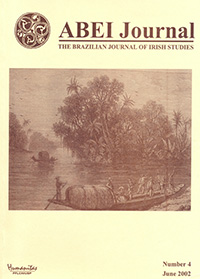James Joyce and the Life Cycle: The Unfolded Picture
DOI:
https://doi.org/10.11606/issn.2595-8127.v4i1p113-124Keywords:
James Joyce, Life cycle, A Portrait of an Artist as a Young Man, Dubliners, Ulysses, Finnegans WakeAbstract
Joyce in his fiction ambitiously attempted to capture the whole of the human life cycle “from infancy through maturity to decay,” as he graphically phrases it in Ulysses (697). Beginning with the child’s earliest memories in A Portrait of an Artist as a Young Man and progressing through the vicissitudes of childhood, recorded in that novel along with the early stories in Dubliners, Joyce went on to analyze adolescence and early adulthood in the middle stories
in Dubliners, as well as in the bulk of A Portrait of an Artist as a Young Man. He then memorably depicted the middle mature years in his portrait of Leopold
and Molly Bloom in Ulysses. Finally, he pictured the evening of life in “The Dead” and its end and re-beginning in Finnegans Wake. Joyce’s works taken as
a whole from A Portrait of the Artist as a Young Man and Dubliners through Ulysses and Exiles to Finnegans Wake – embody Erik Erickson’s “meaningful
interplay between beginning and end as well as some finite sense of summary and, possibly, a more active anticipation of dying.”
References
Augustine, Saint. The Confessions of St. Augustine. Trans. Rex Warner. New York: Mentor, 1963.
Bloom, Harold. Shakespeare: The Invention of the Human. New York: Riverhead, 1998.
Dettmar, Kevin J. J. The Illicit Joyce of Postmodernism: Reading Against the Grain. Madison: U of Wisconsin P, 1996.
Erikson, Erik H. Identity and the Life Cycle. 1980. New York: Norton, 1994.
____. The Life Cycle Completed. Extended Version. 1997. New York: Norton, 1998.
Fiedler, Leslie. “Bloom on Joyce: or, Jokey for Jacob.” New Light on Joyce from the Dublin Symposium. Ed. Fritz Senn. Bloomington: Indiana UP, 1972. 195-208.
Gifford, Don. “A Memory at the Elbow: The Teaching of James Joyce’s Ulysses.” ADE Bulletin. 76 (Winter 1983):43-45.
____, with Robert J. Siedman. Ulysses Annotated: Notes for James Joyce’s Ulysses. Rev. and expanded ed. Berkeley: U of California P, 1988.
Goh, Robbie B. H., ed. Conflicting Identities: Essays on Modern Irish Literature. Singapore: Uni P, 1997.
Johnston, Jennifer. Fool’s Sanctuary. London: Penguin, 1988.
Joyce, James. Dubliners. 1914. In Joyce, The Essential James Joyce. 22-173.
____. The Essential James Joyce. Ed. Harry Levin. St. Albas, HERTZ: Triad, 1977.
____. Finnegans Wake. 1939. New York: Penguin, 1959.
____. A Portrait of an Artist as a Young Man. 1916. In Joyce, The Essential James Joyce. 175-365.
____. Ulysses. 1922. New York: Random House, 1961.
Jung, Karl. “Stages of Life.” 1930. Trans. R. F. C. Hull. The Portable Jung. Ed. Joseph Campbell. New York: Viking, 1971. 3-22.
Kirkwood, Tom. Time of Our Lives: The Science of Human Aging. New York: Oxford UP, 1999.
Lanters, José. “Old Worlds, New Worlds, Alternative Worlds: Ulysses, Metamorphoses 13, and the
Death of the Beloved Son.” James Joyce Quarterly 36.3 (1999): 525-40.
LeClair, Tom. The Art of Excess: Mastery in Contemporary American Fiction. Urbana: U of Illinois P, 1989.
Levitt, Morton. “Editor’s Introduction.” Journal of Modern Literature 24.1 (2000): 5-6.
Morse, Donald. “ ‘The Days of Time’: Overcoming Isolation in Ulysses.” In Goh 77-97
Peake, Charles. James Joyce: The Citizen and the Artist. Stanford, Stanford University Press, 1977.
Rice, Thomas J. “Subtle Reflections of/upon Joyce in/by Borges.” Journal of Modern Literature 24.1 (2000): 47-62.
Ronseley, Joseph. “Leopold Bloom: The Manly Man.” In Goh 99-119.
Rosenfield, Israel. The Invention of Memory: A New View of the Brain. New York: Basic Books, 1988.
Schwarz-Bart. The Last of the Just. (Le dernier des justes.) Trans. Stephen Becker. New York: Atheneum, 1960.
Downloads
Published
Issue
Section
License
Copyright (c) 2002 Donald E. Morse

This work is licensed under a Creative Commons Attribution-NonCommercial 4.0 International License.


